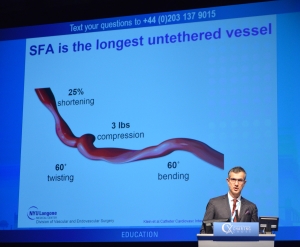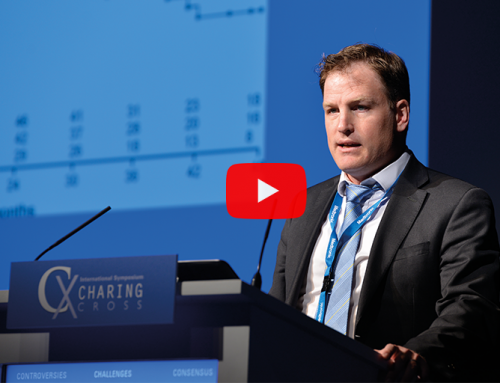
The management of the superficial femoral artery be at the centre of the discussions at the CX Peripheral Arterial Challenges Day of the Charing Cross Symposium 2016. Treatment strategies, depending on lesion type and length, will be analysed and there will be special emphasis on the status and expectations with different modalities: drug-coated balloons, drug-eluting stents, new stents (swirling flow and biomimetic stents) and stent grafts.
There is high expectation of what can be achieved by drug-coated balloons, yet there is healthy scepticism on how durable they will be for longer lesions. “It may take two to three years before we know for sure how the drug-coated balloon compares with stents particularly for longer lesions,” says Roger Greenhalgh, chairman of the CX Programme Organising Board. “All current options will be explored at Charing Cross 2016.”

Roger Greenhalgh
He adds, “Stents are used more commonly for longer lesions and better results are sought by engaging swirling flow or stents with strong radial strength. Data on these technologies will be discussed at CX. Additionally, the value of drug-eluting stents has been demonstrated with five-year data and now newer scaffolds are available.”
Data on other technologies (atherectomy, sequential stents and single long stents), which are being used in the treatment of long lesions, will also be discussed.
Delegates at CX 2016 will also witness new data on the IN-PACT drug-coated balloon two-year results in women and diabetics and data from IN.PACT Global in total occlusions.
Concerns regarding in-stent restenosis will be addressed with a specific Mini-symposium on this subject, which will explore various treatment strategies including drug-coated balloons, stent grafts, laser debulking and covered stents and angioplasty or a combination of some of these technologies.
More serious chronic ischaemia is associated with below-the-knee arterial pathology and for the first time at Charing Cross there will be a Mini-symposium on wound healing. “This Mini-symposium will investigate whether healing is entirely a matter of control of diabetes and revascularisation or if there are methods of encouraging healing, which relate to none of the established accepted criteria such as increasing blood flow,” comments Greenhalgh.
Insights into peripheral arterial challenges
CX Programme Organising Board Members Cliff Shearman (Southampton, UK) and Giovanni Torsello (Münster, Germany) and Faculty Member, Theodosios Bisdas (Münster, Germany), speak about the current peripheral arterial challenges and the use of drug-coated balloons and stents in the superficial femoral artery.

Cliff Shearman, Giovanni Torsello and Theodosios Bisdas
What do you think are the biggest challenges treating peripheral arterial disease?
Cliff Shearman (CS): The lack of understanding of the disease processes and factors influencing progression. At present, we only have tools to modify the condition at the end stages, eg. critical limb ischaemia. There has been no high quality evidence produced in this area compared for instance with carotid and aortic aneurysm disease, which means that current therapies are based more on personal bias rather than evidence.
Giovanni Torsello (GT) and Theodosios Bisdas (TB): We now have in our armamentarium a number of different materials and devices to treat peripheral arterial disease. The majority of those devices have shown excellent results in well-designed randomised controlled trials including patients with TASC A and B lesions and Rutherford categories 1 to 4. However, the literature is lacking on evidence about the safety and efficacy of those technologies in more challenging populations, namely patients with long occlusions, critical limb ischaemia, severe calcification and dialysis. These patients are typically excluded in the majority of randomised controlled trials and remain the biggest challenges that physicians are facing treating peripheral arterial disease. Last but not least, the financial burden of using all these new technologies in our tax- and insurance-funded healthcare systems without any evidence about cost-effectiveness is probably the biggest challenge for physicians.
What are the main challenges around the use of drug-coated balloons in the superficial femoral artery and their durability?
CS: The lack of convincing clinical evidence such as reduction in symptoms or avoidance of amputation in treated patients compared to those managed conventionally. Unless these data are available, it is impossible to draw any views on the cost-effectiveness of the devices. The cost will be a major factor even if benefit is demonstrated.
GT/TB: The introduction of drug-coated balloons in the femoropopliteal lesions has the potential to change the paradigm of treatment in patients with peripheral arterial disease. The two-year results from prospective, randomised controlled trials demonstrated continued superiority of the drug-coated balloon over percutaneous transluminal angioplasty and a very encouraging reduction in the need for reinterventions after local delivery of paclitaxel. However, further assessment of the durability of drug-coated balloons in de novo lesions is mandatory considering the surprising catch-up phenomenon of percutaneous transluminal angioplasty over drug-coated balloons at three years after treatment of in-stent restenosis in diabetics (DEBATE-ISR). Furthermore, all randomised controlled trials demonstrate superiority of drug-coated balloons over percutaneous transluminal angioplasty for short- to intermediate-length lesions, but the benefit of drug-coated balloons for longer lesions (>18cm) and more complex lesion subsets, namely severely calcified lesions and thrombus-containing lesions, has not been proven.
Is there a consensus in relation to drug-coated balloons vs. stents?
CS: The disappointing long-term results with drug-eluting stents have prompted drug-coated balloons with the concept of “leaving nothing behind”. I think there is scepticism about the drug penetration into diseased atherosclerotic arteries (compared to most of the validation work in animal arteries) and again lack of convincing clinical evidence of benefit. My impression is that this will be a short-lived therapy.
GT/TB: We have an increased number of evidence as to the effectiveness of both drug-coated balloons and stents in symptomatic femoropopliteal arterial disease, but no direct comparison exists. At present, there are no algorithms for using the one or the other treatment option. A consensus including all involved specialties (vascular surgeons, cardiologists, radiologists) about drug-eluting technologies would be of great importance and would guide decision-making among vascular specialists.
Join the discussion of these and more topics in the peripheral arterial field at the CX Peripheral Arterial Challenges Day on Tuesday 26 April, Olympia Grand, London, UK
Click here to see the CX Interactive Main Programme – Peripheral Arterial Challenges
Click here to register







